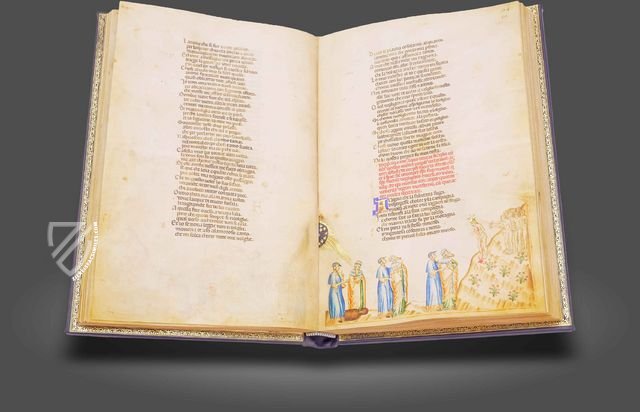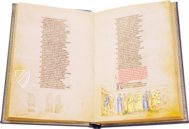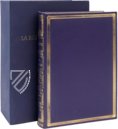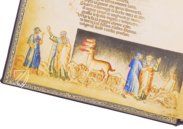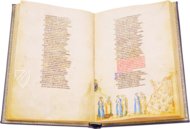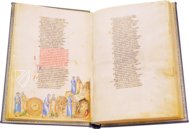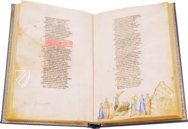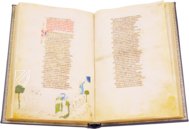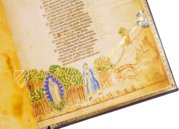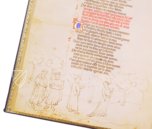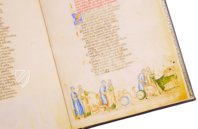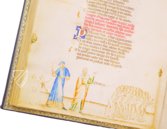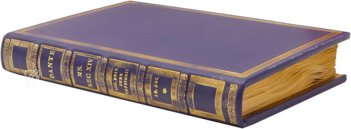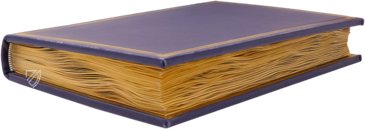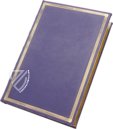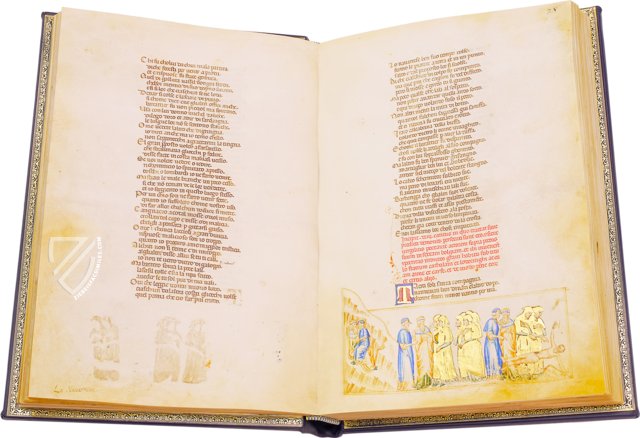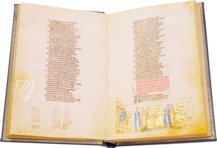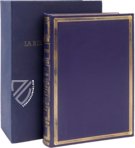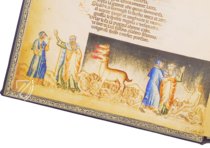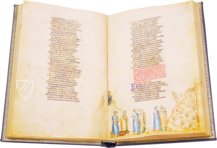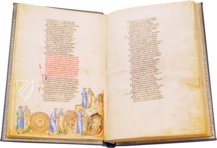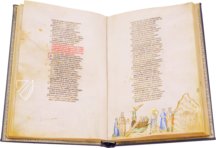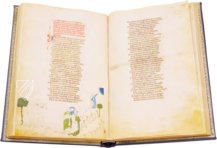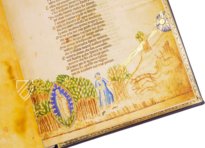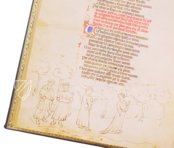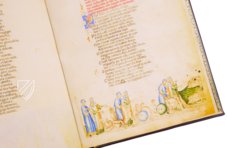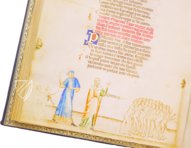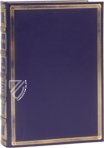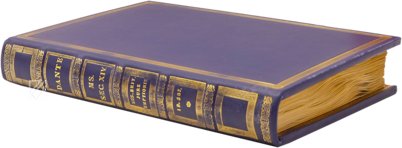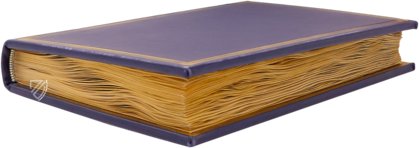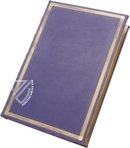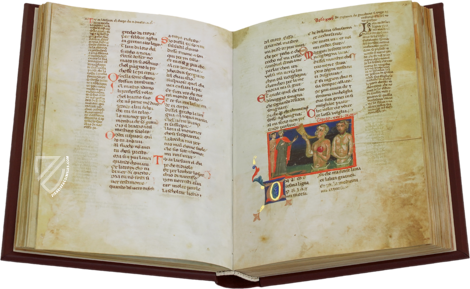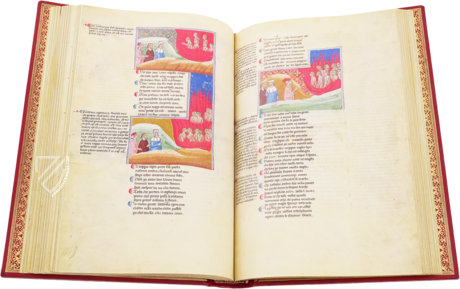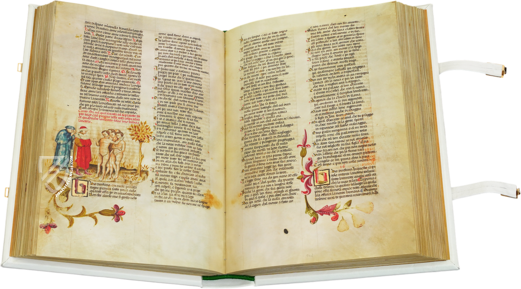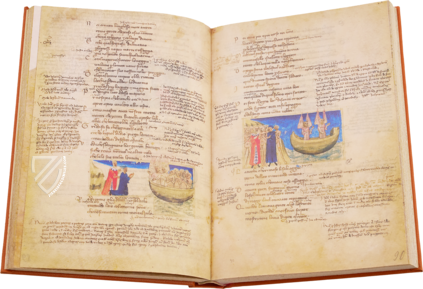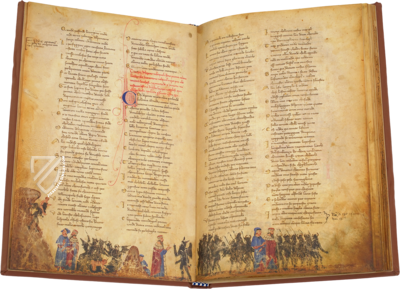Divine Comedy - Add. 19587 Manuscript
(3,000€ - 7,000€)
This ornate copy of Dante's magnum opus was produced in Naples around 1370 and is one of the most beautiful manuscripts of the Divina Commedia, although its wonderful Trecento illumination remained unfinished. Only 48 bas-de-page miniatures were completed by an unknown master. They are finely executed, lovingly colored and enhanced with a subtle use of gold leaf. The main roles in all the scenes are taken by Dante and his ancient guide Virgil, who leads him through the three realms of the world beyond, Hell, Purgatory and Paradise. Furthermore, the Incipit page of the Purgatorio delights with a magnificent border, a large historiated initial and a framed miniature, while the preliminary sketches of the unfinished bas-de-page scenes provide an fascinating insight into the production of medieval manuscripts. Also noteworthy is the last page of the codex, which contains entries on the births and deaths of the Italian noble family Monforte, who ruled the county of Biseglia near Naples in the 15th century and were in possession of the manuscript at the time.
Divine Comedy - Add. 19587 Manuscript
The Divine Comedy is the famous major work of the Italian poet Dante Alighieri (1265-1321). He worked for over 10 years on this piece of world literature consisting of 100 cantos, which is an allegory for the soul's search for God. In three parts of roughly equal length, Dante undertakes a literary journey in the first person through the three realms of the world beyond: Hell (Inferno), Purgatory (Purgatorio) and Paradise (Paradiso). He encounters numerous historical, biblical and mythological figures along the way. His guide through the first two books is Virgil, whom he greatly admires. However, as he comes from pre-Christian times and is therefore not baptized, he is replaced in Paradise by Beatrice, who represents Dante's ideal of women, and later Bernhard of Clairvaux.
Numeric Symbolism
The structure of the work, dominated by the number three, refers to the trinity of God the Father, Christ and the Holy Spirit. The poem is not only divided into the three books mentioned, it was also written by Dante in tercets, also known as terza rima, a three-part verse format that the poet strongly influenced and perhaps even invented. In addition, each book consists of 33 cantos, with a prologue preceding the Inferno. The number 33 was usually interpreted in the Middle Ages as a reference to Christ, as Jesus is said to have suffered his death on the cross at that age.
A Neapolitan Copy
The Manuscript Add. 19587 from the British Library, was written about 50 years after the completion of the Opus Magnum. A talented scribe copied the work of poetry around 1370 in Naples in a neat Gothic rotunda, with each page being taken up by just one column lightly applied to the parchment. 17 pages were added later by a less skilled scribe. Each tercet stanza begins with a majuscule set off to the left, the chants are introduced by extensive Latin rubrics in red ink and a golden champie initial each.
Unfinished Bas-de-Page illuminations
58 pages were provided with artful bas-de-page miniatures by a virtuoso illuminator in a Florentine style, although the illumination was never completed. Only the first 48 scenes of the Inferno and Purgatorio were worked out in detail and softly colored with great skill. Dante and Virgil can be seen in every miniature, Virgil always leading the blue-robed Dante. They are usually depicted slightly larger than the other figures, which emphasizes Dante's journey in relation to the individual events.
10 bas-de-pages are prepared merely as sketches and are also found in the second book on Purgatory, so that the cantos to Paradise remain completely unilluminated. The inspiration for the miniatures, which are nevertheless of the highest quality, may have been the Codex Filippino, also created in Naples, a copy of the Divina Commedia from around 1350 decorated by an other Florentine illuminator.
Codicology
- Alternative Titles
- La Divina Commedia Add. Ms. 19587
Dante Alighieri: Göttliche Kommödie - Codex Add. 19587 - Size / Format
- 354 pages / 36.5 × 24.5 cm
- Origin
- Italy
- Date
- Ca. 1370
- Epochs
- Style
- Genre
- Script
- Gothic Textura Rotunda
- Illustrations
- 58 bas-de-page miniatures, 10 of which are unfinished, one page with a historiated initial and an opulent border, as well as numerous decorated initials
- Content
- Dante's Divine Comedy
- Previous Owners
- Monforte family
Edward Craven Hawtrey
British Museum
Divine Comedy - Add. 19587 Manuscript
Virgil Appears to Dante
In the first canto, which functions as a prologue to the work, Dante loses his way in a dark forest that leads him to the Mountain of Virtue. Full of hope, he sees the sun rise over the mountain ridge, which he then wants to climb. However, a panther, a lion and a she-wolf get in his way. As he is pushed back by the terrifying animals, Virgil appears to him, clearly recognizable here as a vision sent by God through the golden mandorla surrounding him. He helps Dante out of his predicament and leads him on the arduous journey to paradise.
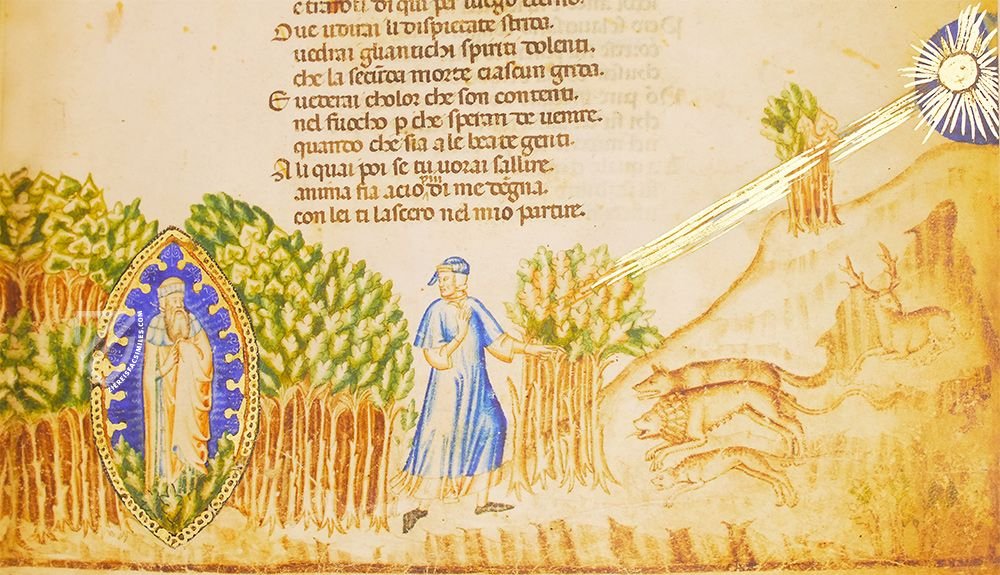
Divine Comedy - Add. 19587 Manuscript
Incipit to Book 2 - Purgatorio
The first canto of Purgatorio begins with a sailing metaphor: having just escaped from hell, Dante and Virgil now set sail for more gentle waters. This image is taken up in the historiated initial 'P' at the beginning of the page, which shows the two poets in a small sailing boat.
The ornate page is completely framed by a lavishly gold-decorated border of geometric and floral elements in blue, red and green. Small medallions and quatrefoils embrace nude human figures and three coats of arms of the Rinaldeschi family, while several rabbits frolic around the framed bas-de-page miniature. Here, an angel cradles the naked souls of people pleading for mercy.
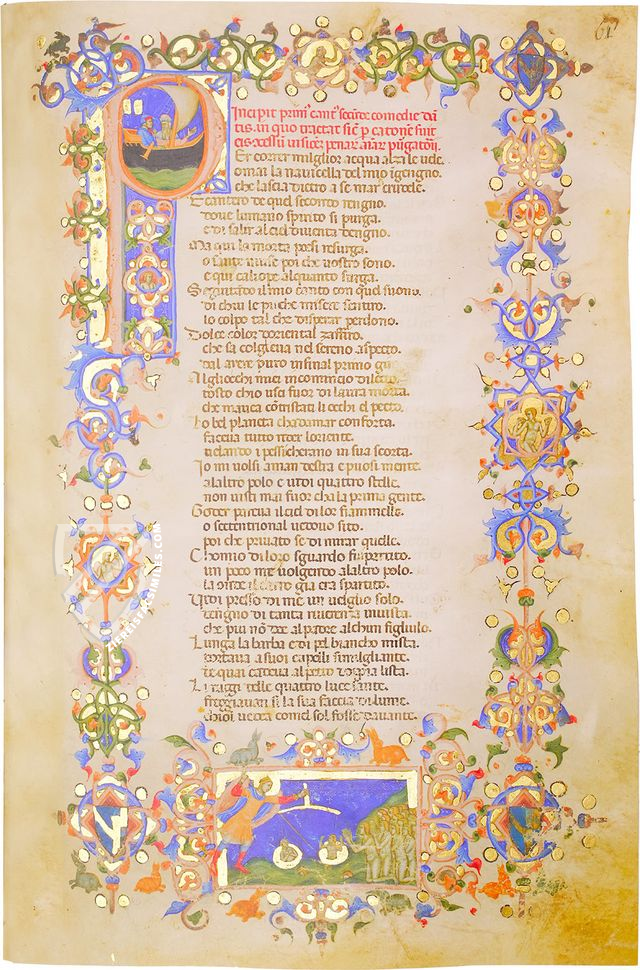
#1 La Divina Commedia Add. Ms. 19587
Language: Italian
(3,000€ - 7,000€)
- Treatises / Secular Books
- Apocalypses / Beatus
- Astronomy / Astrology
- Bestiaries
- Bibles / Gospels
- Chronicles / History / Law
- Geography / Maps
- Saints' Lives
- Islam / Oriental
- Judaism / Hebrew
- Single Leaf Collections
- Leonardo da Vinci
- Literature / Poetry
- Liturgical Manuscripts
- Medicine / Botany / Alchemy
- Music
- Mythology / Prophecies
- Psalters
- Other Religious Books
- Games / Hunting
- Private Devotion Books
- Other Genres
- Afghanistan
- Armenia
- Austria
- Belgium
- Belize
- Bosnia and Herzegovina
- China
- Colombia
- Costa Rica
- Croatia
- Cyprus
- Czech Republic
- Denmark
- Egypt
- El Salvador
- Ethiopia
- France
- Germany
- Greece
- Guatemala
- Honduras
- Hungary
- India
- Iran
- Iraq
- Israel
- Italy
- Japan
- Jordan
- Kazakhstan
- Kyrgyzstan
- Lebanon
- Liechtenstein
- Luxembourg
- Mexico
- Morocco
- Netherlands
- Palestine
- Panama
- Peru
- Poland
- Portugal
- Romania
- Russia
- Serbia
- Spain
- Sri Lanka
- Sweden
- Switzerland
- Syria
- Tajikistan
- Turkey
- Turkmenistan
- Ukraine
- United Kingdom
- United States
- Uzbekistan
- Vatican City
- A. Oosthoek, van Holkema & Warendorf
- Aboca Museum
- Ajuntament de Valencia
- Akademie Verlag
- Akademische Druck- u. Verlagsanstalt (ADEVA)
- Aldo Ausilio Editore - Bottega d’Erasmo
- Alecto Historical Editions
- Alkuin Verlag
- Almqvist & Wiksell
- Amilcare Pizzi
- Andreas & Andreas Verlagsbuchhandlung
- Archa 90
- Archiv Verlag
- Archivi Edizioni
- Arnold Verlag
- ARS
- Ars Magna
- ArtCodex
- AyN Ediciones
- Azimuth Editions
- Badenia Verlag
- Bärenreiter-Verlag
- Belser Verlag
- Belser Verlag / WK Wertkontor
- Benziger Verlag
- Bernardinum Wydawnictwo
- BiblioGemma
- Biblioteca Apostolica Vaticana (Vaticanstadt, Vaticanstadt)
- Bibliotheca Palatina Faksimile Verlag
- Bibliotheca Rara
- Boydell & Brewer
- Bramante Edizioni
- Bredius Genootschap
- Brepols Publishers
- British Library
- C. Weckesser
- Caixa Catalunya
- Canesi
- CAPSA, Ars Scriptoria
- Caratzas Brothers, Publishers
- Carus Verlag
- Casamassima Libri
- Centrum Cartographie Verlag GmbH
- Chavane Verlag
- Christian Brandstätter Verlag
- Circulo Cientifico
- Club Bibliófilo Versol
- Club du Livre
- CM Editores
- Collegium Graphicum
- Collezione Apocrifa Da Vinci
- Comissão Nacional para as Comemorações dos Descobrimentos Portugueses
- Coron Verlag
- Corvina
- CTHS
- D. S. Brewer
- Damon
- De Agostini/UTET
- De Nederlandsche Boekhandel
- De Schutter
- Deuschle & Stemmle
- Deutscher Verlag für Kunstwissenschaft
- DIAMM
- Droz
- E. Schreiber Graphische Kunstanstalten
- Ediciones Boreal
- Ediciones Grial
- Ediclube
- Edições Inapa
- Edilan
- Editalia
- Edition Deuschle
- Edition Georg Popp
- Edition Leipzig
- Edition Libri Illustri
- Editiones Reales Sitios S. L.
- Éditions de l'Oiseau Lyre
- Editions Medicina Rara
- Editorial Casariego
- Editorial Mintzoa
- Editrice Antenore
- Editrice Velar
- Edizioni Edison
- Egeria, S.L.
- Eikon Editores
- Electa
- Emery Walker Limited
- Enciclopèdia Catalana
- Eos-Verlag
- Ephesus Publishing
- Ernst Battenberg
- Eugrammia Press
- Extraordinary Editions
- Fackelverlag
- Facsimila Art & Edition
- Facsimile Editions Ltd.
- Facsimilia Art & Edition Ebert KG
- Faksimile Verlag
- Feuermann Verlag
- Folger Shakespeare Library
- Franco Cosimo Panini Editore
- Friedrich Wittig Verlag
- Fundación Hullera Vasco-Leonesa
- G. Braziller
- Gabriele Mazzotta Editore
- Gebr. Mann Verlag
- Gesellschaft für graphische Industrie
- Getty Research Institute
- Giovanni Domenico de Rossi
- Giunti Editore
- Graffiti
- Grafica European Center of Fine Arts
- Guido Pressler
- Guillermo Blazquez
- Gustav Kiepenheuer
- H. N. Abrams
- Harrassowitz
- Harvard University Press
- Helikon
- Hendrickson Publishers
- Henning Oppermann
- Herder Verlag
- Hes & De Graaf Publishers
- Hoepli
- Holbein-Verlag
- Houghton Library
- Hugo Schmidt Verlag
- Idion Verlag
- Il Bulino, edizioni d'arte
- ILte
- Imago
- Insel Verlag
- Insel-Verlag Anton Kippenberger
- Instituto de Estudios Altoaragoneses
- Instituto Nacional de Antropología e Historia
- Introligatornia Budnik Jerzy
- Istituto dell'Enciclopedia Italiana - Treccani
- Istituto Ellenico di Studi Bizantini e Postbizantini
- Istituto Geografico De Agostini
- Istituto Poligrafico e Zecca dello Stato
- Italarte Art Establishments
- Jan Thorbecke Verlag
- Johnson Reprint Corporation
- Josef Stocker
- Josef Stocker-Schmid
- Jugoslavija
- Karl W. Hiersemann
- Kasper Straube
- Kaydeda Ediciones
- Kindler Verlag / Coron Verlag
- Kodansha International Ltd.
- Konrad Kölbl Verlag
- Kurt Wolff Verlag
- La Liberia dello Stato
- La Linea Editrice
- La Meta Editore
- Lambert Schneider
- Landeskreditbank Baden-Württemberg
- Leo S. Olschki
- Les Incunables
- Liber Artis
- Library of Congress
- Libreria Musicale Italiana
- Lichtdruck
- Lito Immagine Editore
- Lumen Artis
- Lund Humphries
- M. Moleiro Editor
- Maison des Sciences de l'homme et de la société de Poitiers
- Manuscriptum
- Martinus Nijhoff
- Maruzen-Yushodo Co. Ltd.
- MASA
- Massada Publishers
- McGraw-Hill
- Metropolitan Museum of Art
- Militos
- Millennium Liber
- Müller & Schindler
- Nahar - Stavit
- Nahar and Steimatzky
- National Library of Wales
- Neri Pozza
- Nova Charta
- Oceanum Verlag
- Odeon
- Orbis Mediaevalis
- Orbis Pictus
- Österreichische Staatsdruckerei
- Oxford University Press
- Pageant Books
- Parzellers Buchverlag
- Patrimonio Ediciones
- Pattloch Verlag
- PIAF
- Pieper Verlag
- Plon-Nourrit et cie
- Poligrafiche Bolis
- Presses Universitaires de Strasbourg
- Prestel Verlag
- Princeton University Press
- Prisma Verlag
- Priuli & Verlucca, editori
- Pro Sport Verlag
- Propyläen Verlag
- Pytheas Books
- Quaternio Verlag Luzern
- Reales Sitios
- Recht-Verlag
- Reichert Verlag
- Reichsdruckerei
- Reprint Verlag
- Riehn & Reusch
- Roberto Vattori Editore
- Rosenkilde and Bagger
- Roxburghe Club
- Salerno Editrice
- Saltellus Press
- Sandoz
- Sarajevo Svjetlost
- Schöck ArtPrint Kft.
- Schulsinger Brothers
- Scolar Press
- Scrinium
- Scripta Maneant
- Scriptorium
- Shazar
- Siloé, arte y bibliofilia
- SISMEL - Edizioni del Galluzzo
- Sociedad Mexicana de Antropología
- Société des Bibliophiles & Iconophiles de Belgique
- Soncin Publishing
- Sorli Ediciones
- Stainer and Bell
- Studer
- Styria Verlag
- Sumptibus Pragopress
- Szegedi Tudomànyegyetem
- Taberna Libraria
- Tarshish Books
- Taschen
- Tempus Libri
- Testimonio Compañía Editorial
- Thames and Hudson
- The Clear Vue Publishing Partnership Limited
- The Facsimile Codex
- The Folio Society
- The Marquess of Normanby
- The Richard III and Yorkist History Trust
- Tip.Le.Co
- TouchArt
- TREC Publishing House
- TRI Publishing Co.
- Trident Editore
- Tuliba Collection
- Typis Regiae Officinae Polygraphicae
- Union Verlag Berlin
- Universidad de Granada
- University of California Press
- University of Chicago Press
- Urs Graf
- Vallecchi
- Van Wijnen
- VCH, Acta Humaniora
- VDI Verlag
- VEB Deutscher Verlag für Musik
- Verlag Anton Pustet / Andreas Verlag
- Verlag Bibliophile Drucke Josef Stocker
- Verlag der Münchner Drucke
- Verlag für Regionalgeschichte
- Verlag Styria
- Vicent Garcia Editores
- W. Turnowski Ltd.
- W. Turnowsky
- Waanders Printers
- Wiener Mechitharisten-Congregation (Wien, Österreich)
- Wissenschaftliche Buchgesellschaft
- Wissenschaftliche Verlagsgesellschaft
- Wydawnictwo Dolnoslaskie
- Xuntanza Editorial
- Zakład Narodowy
- Zollikofer AG

